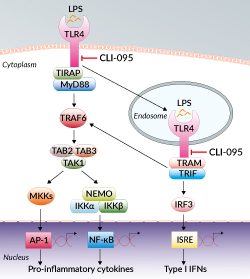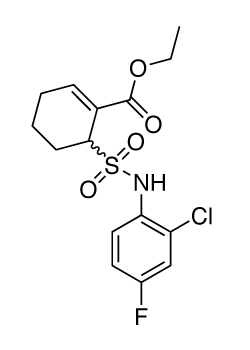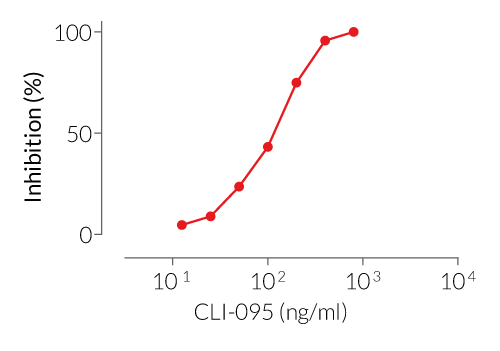CLI-095
| Product | Unit size | Cat. code | Docs. | Qty. | Price | |
|---|---|---|---|---|---|---|
|
CLI-095 TLR4 signaling inhibitor - InvitroFit™ |
Show product |
4 x 1 mg |
tlrl-cli95-4
|
|
TLR4 inhibitor

TLR4 signaling inhibition by CLI-095
CLI-095, also known as resatorvid or TAK-242, is a cyclohexene derivative that specifically suppresses TLR4 signaling [1]. TLR4 is a pattern recognition receptor that recognizes bacterial lipopolysaccharide (LPS). Its activation mainly leads to the synthesis of pro-inflammatory cytokines and chemokines.
Mode of action:
CLI-095 is a small-molecule inhibitor of TLR4 signaling. It acts by blocking the signaling mediated by the intracellular domain of TLR4. More precisely, CLI-095 attaches to cysteine 747 in the intracellular sphere of TLR4, thus hindering both MyD88-dependent and TRIF-dependent pathways stimulated by LPS [2].
There are two distinct signaling cascades triggered by the dimerization of TLR4; the MyD88-dependent (at the cell surface) and TRIF-dependent (in endosomes) pathways. At the cell surface, activation of TLR4 initiates the MyD88-dependent pathway, ultimately leading to the ‘early’ activation of NF-κB and the production of a pro-inflammatory response [3]. Subsequently, the TLR4 complex can be endocytosed into endosomes and result in the ‘late’ activation of NF-κB as well as the stimulation of IRF3 (interferon regulatory factor), which modulates the expression of type I interferons (IFNs) [4].
Interestingly, when tested in vivo, CLI-095 has been shown to reduce the inflammatory responses in different disease models [5, 6].
Key features:
- A potent and specific inhibitor of TLR4
- InvitroFit™ grade: each lot is highly pure (≥95%) and functionally tested
References
1. Li M. et al., 2006. A Novel Cyclohexene Derivative, Ethyl (6R)-6-[N-(2-Chloro-4- fluorophenyl)sulfamoyl]cyclohex-1-ene-1-carboxylate (TAK-242), Selectively Inhibits Toll-Like Receptor 4-Mediated Cytokine Production through Suppression of Intracellular Signaling. Mol. Pharmacol., 69:1288-1295.
2. Kawamoto T. et al., 2008. TAK-242 selectively suppresses Toll-like receptor 4-signaling mediated by the intracellular domain. Eur J Pharmacol. 584(1):40-8.
3. Kuzmich N.N. et al., 2017. TLR4 Signaling Pathway Modulators as Potential Therapeutics in Inflammation and Sepsis. Vaccines (Basel) 5.
4. Marongiu L. et al., 2019. Below the surface: The inner lives of TLR4 and TLR9. J Leukoc Biol 106, 147-160.
5. Wang X.Q . et al., 2016. CLI-095 decreases atherosclerosis by modulating foam cell formation in apolipoprotein E-deficient mice. Mol Med Rep. 14(1):49-56.
6. Alibashe-Ahmed M. et al., 2019. Toll-like receptor 4 inhibition prevents autoimmune diabetes in NOD mice. Sci Rep. 9(1):19350.
Specifications
CAS number: 243984-11-4
Solubility: DMSO (1 mg/ml), Methanol (1 mg/ml)
Molecular weight: 361.82 g/mol
Working concentration: 50 nM - 5 μM
Quality control:
- Purity ≥ 95% (UHPLC)
- The inhibitory activity has been validated using cellular assays.
- The absence of bacterial contamination (e.g. lipoproteins and endotoxins) is confirmed using HEK-Blue™ TLR2 and HEK-Blue™ TLR4 cells.
Contents
CLI-095 is provided as a solid.
- 4 x 1 mg CLI-095
![]() CLI-095 is shipped at room temperature.
CLI-095 is shipped at room temperature.
![]() Upon receipt, store at -20°C.
Upon receipt, store at -20°C.
Back to the top
Details
TLR4
Toll-like receptor 4 (TLR4) was the first TLR identified and is an important pattern recognition receptor (PRR) in innate immunity and inflammation. TLR4 is found both on the cell surface and in endosomes of innate immune cells including monocytes and macrophages, as well as on intestinal epithelium and endothelial cells [1]. TLR4 primarily recognizes and is activated by lipopolysaccharide (LPS) and its toxic moiety Lipid A, a core component of Gram-negative bacteria [2]. TLR4 does not directly interact with LPS and requires essential co-receptors, namely lipid-binding protein (LBP), MD-2, and CD14, to extract and deliver monomeric LPS to TLR4 [3]. There are two distinct signaling cascades triggered by the dimerization of TLR4; the MyD88-dependent (at the cell surface) and TRIF-dependent (in endosomes) pathways. At the cell surface, activation of TLR4 initiates the MyD88-dependent pathway, ultimately leading to the ‘early’ activation of NF-κB and the production of a pro-inflammatory response [3]. Subsequently, the TLR4 complex can be endocytosed into endosomes and result in the ‘late’ activation of NF-κB as well as the stimulation of IRF3 (interferon regulatory factor), which modulates the expression of type I interferons (IFNs) [4]. TLR4 signaling is crucial in both acute and chronic inflammatory disorders and is thus an attractive target for novel treatments for conditions such as sepsis and cancer [1].
References:
1. Ou T. et al., 2018. The Pathologic Role of Toll-Like Receptor 4 in Prostate Cancer. Front Immunol 9, 1188.
2. Cochet F. et al., 2017. The Role of Carbohydrates in the Lipopolysaccharide (LPS)/Toll-Like Receptor 4 (TLR4) Signalling. Int J Mol Sci 18
3. Kuzmich N.N. et al., 2017. TLR4 Signaling Pathway Modulators as Potential Therapeutics in Inflammation and Sepsis. Vaccines (Basel) 5.
4. Marongiu L. et al., 2019. Below the surface: The inner lives of TLR4 and TLR9. J Leukoc Biol 106, 147-160.
Chemical structure of CLI-095:







